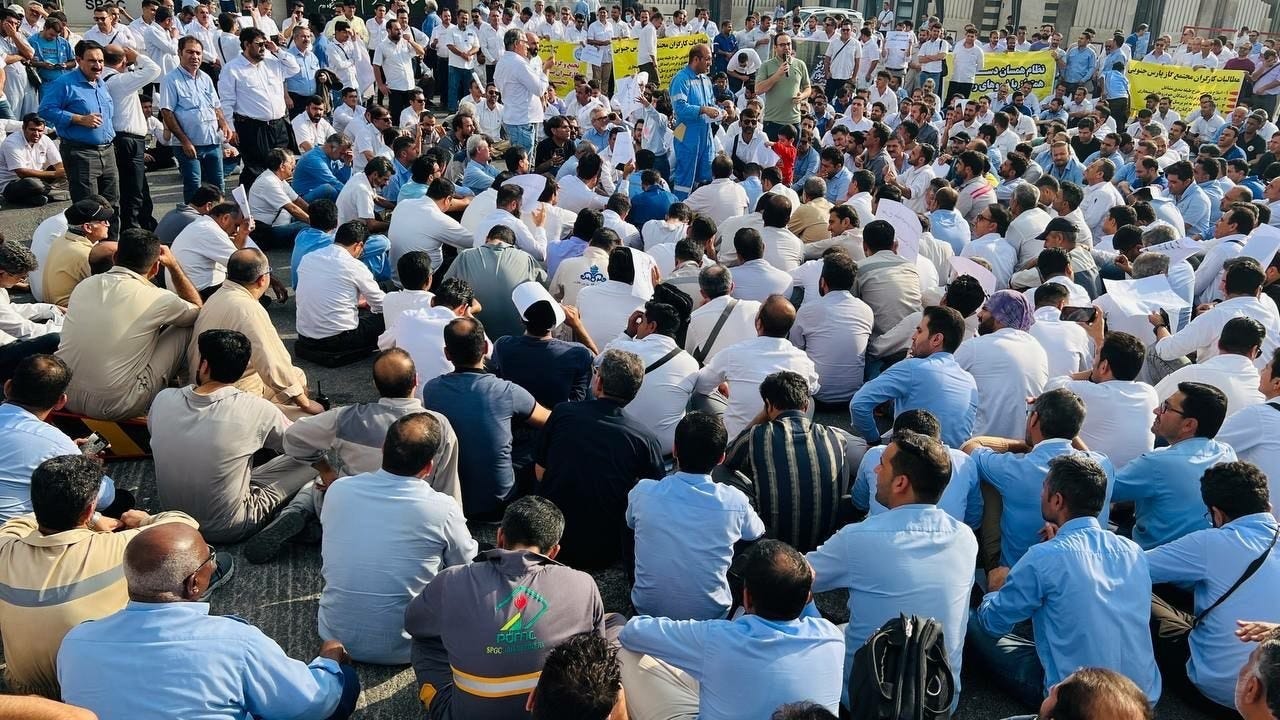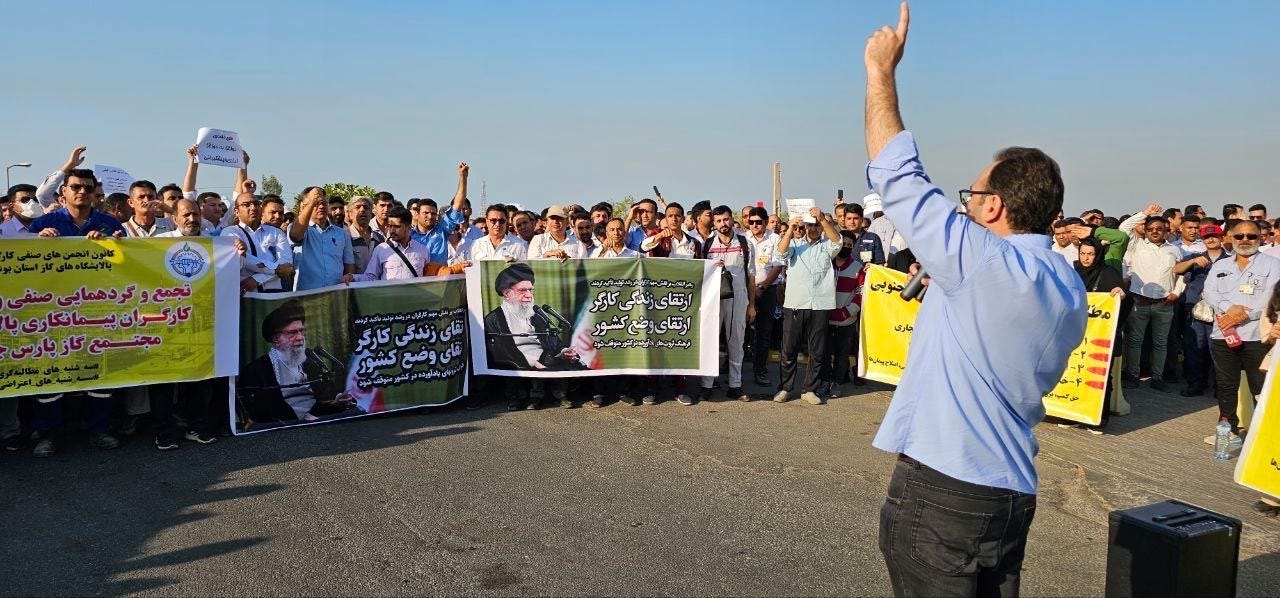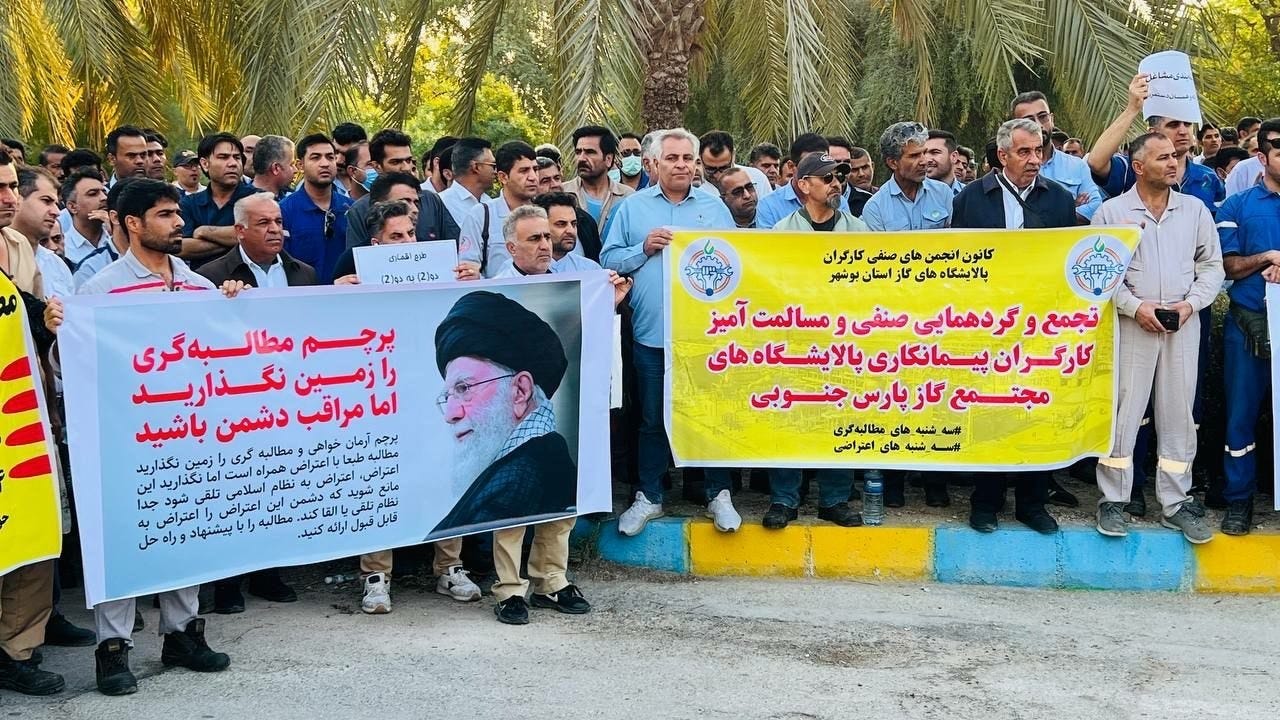Striking oil workers at South Pars field in Bushehr province on Tuesday, November 4, 2025. Image provided to Drop Site News.
Fifteen thousand workers went on strike at a major gas field in Iran last week, demanding improved wages and working conditions at the economically critical South Pars field. Earlier this month, the Association of Gas Industry Workers’ Unions of Bushehr Province—the largest labor organization representing the workers of Iran’s gas refineries at South Pars—announced a weekly work stoppage over longstanding grievances at the site.
A letter announcing the strike, authored by union head Alireza Mirghaffari, laid out several key demands that the workers had put to Iranian authorities related to inequitable pay, difficult working conditions, and inadequate leave time for workers at the site. Many of the demands also point to widespread unhappiness over wage suppression and violation of labor laws. The conditions, the letter said, “long burdened those who sustain this key industry and source of Iran’s national wealth.”
“South Pars produces 40% of Iran’s income and 70% of the energy of the nation. So it is an incredibly strategic place for workers to have power, and to be able to build a base to achieve our demands,” Mirghaffari told Drop Site.
A large portion of Iran’s oil and gas workforce is employed through temporary contracts or as private contractors rather than as permanent employees, leaving them without stable wages, benefits, or job security, and vulnerable to dismissal if they speak out. Inflationary pressures triggered by U.S. sanctions and corruption by Iranian officials have also drastically reduced the purchasing power of ordinary Iranians, including those who work in this sector. Iranian oil and gas exports are the country’s most critical economic lifeline, but working in the field has been notoriously grueling for decades—especially in remote areas like Khuzestan and Bushehr where workers face extreme heat and substandard housing conditions.
Striking oil workers at South Pars field in Bushehr province on Tuesday, November 4, 2025. Image provided to Drop Site News.
Striking oil workers at South Pars field in Bushehr province on Tuesday, November 4, 2025. Image provided to Drop Site News.
Mirghaffari told Drop Site that the strike is also intended as an expression of national pride by Iranian workers after their country was directly attacked by Israel and the U.S. over the summer. He described the strike as intended to send a broader message of solidarity, not just to fellow Iranians but to others in the region who have also been under attack.
“Our country is consistently a target of imperialism and our sovereignty has been targeted for decades,” Mirghaffari said. “We see our strike as being in support of the liberation of Palestinians, as well as the struggles of people in Yemen and Lebanon. It is because of our faith and because it is a moral duty, but also because we understand that our interests are intertwined.”
Despite a general climate of political repression inside Iran, labor activism has grown in recent years. Oil and gas workers have launched strikes in several different provinces. In 2021, thousands of refinery workers across the country went on strike to protest poor wages and punishing conditions under the banner “Campaign 1400,” a reference to that the current year in the Islamic calendar used in Iran. Among other demands, that movement demanded wage increases for workers in the sector in response to the rampant inflation after the U.S. withdrawal from the 2015 nuclear deal with Iran and reimposition of sanctions.
“It is very hard for any labor movement in Iran to balance legal concerns and the need to protect the country’s sovereignty, while also fighting the faction within the state that does not see these labor actions as favorable,” said Esmaeel Mohammadvali, a longtime labor activist in Iran who has been documenting the South Pars strike from the ground. “On top of that it is often a struggle to even convince workers themselves that a strike is in their interests because of their job security concerns.”
That this strike is taking place is “nothing less than a miracle,” Mohammadvali continued. “They have been able to do so because of the structure that has been built that allows over 15,000 workers to coordinate and reduce the risk of punishment and retaliation for expressing their demands.”
Labor strikes in Iran are also forced to navigate an increasingly hostile and suspicious relationship with the U.S. and fears that another Israeli attack on Iran may be imminent. In that context workers at South Pars have said that they were policing their movement to protect it from being hijacked by outside actors.
“There are political risks because foreign actors and enemies of the country often try to exploit labor strikes for their own benefit. Labor movements are particularly vulnerable to regime-change operations due to poor economic conditions, sanctions, and internal contradictions, making them easy to hijack,” said Mohammadvali. During the Cold War, the U.S. at times backed labor organizations in Latin America, Asia, and Europe with the aim of destabilizing foreign governments by using legitimate worker grievances as a vehicle to achieve political aims. It is a concern that Mohammadvali says that Iranian oil workers are sensitive to and which led them to draw clear lines in their messaging about the aims of this strike.
“What sets the South Pars labor association apart is that it has been able to protect itself and create a ‘safety zone,’ remaining unreceptive to outside interference,” he said. “Smaller groups were often infiltrated, politicized, or forced to leave the country, causing their struggles to stall or be suppressed. In contrast, South Pars has built trust with both workers and the government, framing their demands as an extension of Iran’s sovereignty.”
Thousands of workers plan to stop work again this coming Tuesday as part of the ongoing labor action at South Pars. In their letter to authorities, the workers wrote, “We will continue to organize, to educate, and to stand in solidarity with workers both within and beyond Iran’s borders, recognizing that the struggle for justice is neither fleeting nor confined—it is the living pulse of a people resolved to uphold integrity, sovereignty.”
From Drop Site News via this RSS feed





